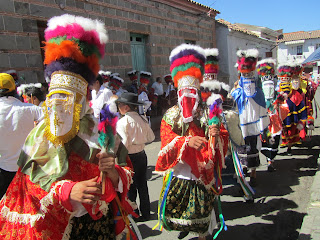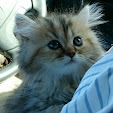 |
| たった1つだけ、珍しいサボテン |
9月24・25日。イギリス人の友人がインカ道を歩くからいこうと誘ってくれました。Mercado Campesinoのさらに先、Parada de Norteに朝7時集合。総勢5人。イギリス人のトム、イタリアのジョルダナ、フランス人のフランシスコ、ボリビア人のアルド、そして私と偶然にもばらばらの国籍だけれど全員タリハ在住。外国人が多いとはいえないタリハ。逆にいえば、トレッキングをしたがるのは外国人くらいだということです。交通網の発達していないボリビアにおいて、歩くことは日常の移動の手段でもあります。緑と水と山の空気を楽しむためのウォーキングの概念はあまりないようです。タリハの自然を知るための最もお金のかからない娯楽。ずっとここを歩きたかった理由は「インカ道(El camino del Inca)」という浪漫のある名前に魅かれたこともあるけれど、学校の課外学習に組み込めないかと考えたからでもあります。今回の行程は一泊。ここまで長いものは無理でも、一部なりと出来ないか探りたいところ。
 |
| 見慣れない顔!? |
まずは小さな乗合バスでサマの山を越えた最初の町イスカヤチ(Iscayachi)へ。少し休憩した後、新たな客を乗せ同じバスがインカ道の入り口タクサラ(Tajsara)へ連れて行ってくれました(45ボリ)。ラグナ・グランデ(Laguna Grande)、通称タクサラ湖(Laguna de Takjsara)はフラミンゴがみれることで知られているけれど、まだ飛来していません。乾季で小さくなった湖を横に歩き始めます。やがてサマ自然保護区(Reserva de Sama)の入り口を示す看板。このタクサラには女性の織物グループがあって、サン・ロケ教会前では草木染めのポンチョやマフラーを初めかわいい小物をたくさん売っています。歩きはじめは平坦。途中でリャマの大群発見。もちろん野生ではありません。オルロに住み、農業に携わる仲間からタリハのリャマは優秀だと聞いています。エリートリャマの集まるリャマコンテストでも注目をひいていたとか。気候と食べ物のせいだろうといいます。トムが言うに、タリハのリャマの飼育は草を根こそぎ食べてしまう羊に変わる家畜として、NGOが導入したのが始まりだそう。リャマは草の葉の部分のみを食べるし、その毛は良質。いいアイディアだと思います。それはともかく、愛嬌あるリャマはかわいくて、ジョルダナと沢山写真をとりました。
 |
| 牛を追う人 |
やがて道は登り坂。始めた地点で2500m辺り。3000mを超えてくる地点になると息切れがして、苦しくなります。ようやく「ここからは下りだよ」という場所でお昼休憩。フランシスコの持ってきたツナに、イタリアに帰っていたばかりというジョージアナの持ってきたおいしいパルメザンチーズ。私は梨と母が送ってくれた飴を提供。二つのvalle(谷)を結ぶこの地点で多くの旅人が休憩をしたとのことで、石塚ができていました。涼しい風の吹く山あいでとる食事は最高。ここからEl Camino de Inca、インカ道の始まりです。丹念に並べられた大きな石。すり減ってなめらかになった表面が年月を感じさせます。この道があのマチュピチュ遺跡から続いてきたのです。けれども目の前にはそんな感傷もふきとばす、悲しい風景も広がっています。美しい山の稜線を引き裂くように走る道路。たった一本の車がすれ違うこともできない道は雑に機械を使って作られたため、山の水の流れを変えてしまい、ひどい土壌侵食と土砂崩れを引き起こしています。そうまでして作った道なのに、私たちが歩いていた数時間の間、走っている車をみることは一台もなかったのです。山に住む人で車を持っている人は少ないという事情もありますが、実際のところあの崩れ具合では車が走ることは早々にできなくなるのではないでしょうか。サマのレンジャー達と働くトムはこうした事情に詳しく、色々と説明してくれます。



ひたすら下る道は上りとは違ったつらさがあり、2時間も歩いた頃にはすっかり足が笑っていました。やがて今日泊まる予定の小さい集落が見えてきました。山小屋があいていれば、そこに、あいていなければ近くの民家に泊めてもらうとの話でした。もう少し、と思いながら前を見ると、ずっと先を歩いていた3人が大地の切れ目で立ち止まっています。さらに遠くの集落を指さすアルド、信じられない、冗談だろという風に大きく手をひろげて片手を頭にやるフランシスコ。それを見て、横を歩くジョルダナも「信じたくないわ」といいます。追いついた私たちにフランシスコは「もし、誰も人がいなければあっちの集落まで歩かないとだめだって言うんだよ。」とどう見ても2・3時間はかかりそうな先にある集落を指さしました。日はもう落ちつつあります。まさかね、と思いつつ、集落にたどり着くと、山小屋は予想通り閉鎖。タリハ仲間が以前インカ道を歩いた際、壊れていた屋根は今はなおされているようです。雨がふってひどい目にあったとか。アルドは山小屋に行くことなく、まっすぐ小さな店に導きます。そしてここに泊まることになったのです。いたずら好きのアルドにまんまと担がれたのでした。


日が落ちてから急激に冷え込んできました。ベットの用意をしてくれるこの家のお母さんは8人の子持ち。その子供達の大半は結婚してブエノスアイレスに住んでいるそうで、年末にはみな帰ってくるとのことです。どこから来たのかという話のあと、話は地震のことに。地面が揺れるのだというと、信じられない様子。カフェ色に染まっているとはいえ、お母さんの顔だちはとても日本人的。アジアからベーリング海峡を経て、北アメリカから南アメリカへ南下してきた人々がいたことを実感します。粗末な小屋ながらろうそくをともし、寒くないようにと毛布をたくさん用意してくれた部屋は居心地よくあたたかでした。夕食を待つ間、お母さんの用意してくれたパスタの煮込み(Guiso de Fideo)を食べながら、そしてお茶とクッキーでくつろぎ、ウイスキーの瓶を回しながら、言葉や習慣、料理を話題に話が咲いたのでした。星は降るように瞬いているけれど、風がひどく吹く大荒れの夜でした。翌日はうってかわってやわらかい朝の光が土で作った家と石垣に囲まれた小さな畑を照らす穏やかで美しい日。山からひいた水は冷たく、揚げたてのブニュエロとコーヒーの朝ご飯がとてもおいしかった。9時、泊まらせてくれた家のお母さんとお父さんに挨拶をして出発(夕飯、朝ご飯込で35ボリ!)。さらに下り、石だらけの川を横切ります。地下水が湧き出て小さな流れをつくり、やがて川になっていく様子がわかります。水量が増え、泳いだら気持ちよさそうな薄い緑いろの澄んだ水たまりがあちこちで見られます。今度は水着を持ってこようと言いあいました。川を離れて再度山を登るつめると目指す村がずっと下に見えました。さらにインカ道をたどり、ごろごろ転がる石の間に足をとられ、とられしつつ歩くこと5時間あまり、ようやく山の麓に到着しました。振り返ると遥かにそびえる山。あそこから降りてきたとは信じられない思いでした。
 |
| 石がごろごろ、ここからさらに登り、 |
 |
| 左下木々が見える場所まで下る。 |

宿のすぐ近くで出会って一緒に下山した2人組イサベルとロセンド(この二日の行程で唯一出会ったハイカー)。新しく旅行会社を始めるのでインカ道のガイドができるように歩いているのだと言います。ロセンドはお祖父さんが日本人とのこと。名字は「シムラ」だそう。戦前アルゼンチンからタリハに来てここに住み着いたそうです。漢字を少し書けるそう。イサベルはPlan Internacionalで働いていたことがある女の子。村をたくさん回っていたそうで、エボ政権
 |
| 到着!タクシーある!? |
は色々と言われているけれど、村の発展に力をいれる彼の政策は効果をあげていると話してくれました。ラパス県に限らず?と聞くと、タリハでもどこでもと。その代わり中産階級以上に対する政策がおざなりだから、彼らからひどく批判されている、全てに万遍なくとはいかないものね、と言います。実際、今回のハイキングで目にした山あいの集落の家々にはソーラーパネルがつけられ、学校は広々と新しく、家々の壁は輝くように白く塗られてシャーガス病の防止を意識し、生活の向上が覗われます。変化がいつからどのように起こり、どこまでがエボ大統領の政策と関わっているのかはわかりませんが、貧富の差をなくすために社会主義政策を推し進めるエボ・モラレス大統領を支持する人々の多くが貧困層である理由がよくわかります。
エボ・モラレス大統領の株がちょっと上がったその翌日。再度がた下がりするようなことが起こったのでした・・・




 日が落ちてから急激に冷え込んできました。ベットの用意をしてくれるこの家のお母さんは8人の子持ち。その子供達の大半は結婚してブエノスアイレスに住んでいるそうで、年末にはみな帰ってくるとのことです。どこから来たのかという話のあと、話は地震のことに。地面が揺れるのだというと、信じられない様子。カフェ色に染まっているとはいえ、お母さんの顔だちはとても日本人的。アジアからベーリング海峡を経て、北アメリカから南アメリカへ南下してきた人々がいたことを実感します。粗末な小屋ながらろうそくをともし、寒くないようにと毛布をたくさん用意してくれた部屋は居心地よくあたたかでした。夕食を待つ間、お母さんの用意してくれたパスタの煮込み(Guiso de Fideo)を食べながら、そしてお茶とクッキーでくつろぎ、ウイスキーの瓶を回しながら、言葉や習慣、料理を話題に話が咲いたのでした。星は降るように瞬いているけれど、風がひどく吹く大荒れの夜でした。翌日はうってかわってやわらかい朝の光が土で作った家と石垣に囲まれた小さな畑を照らす穏やかで美しい日。山からひいた水は冷たく、揚げたてのブニュエロとコーヒーの朝ご飯がとてもおいしかった。9時、泊まらせてくれた家のお母さんとお父さんに挨拶をして出発(夕飯、朝ご飯込で35ボリ!)。さらに下り、石だらけの川を横切ります。地下水が湧き出て小さな流れをつくり、やがて川になっていく様子がわかります。水量が増え、泳いだら気持ちよさそうな薄い緑いろの澄んだ水たまりがあちこちで見られます。今度は水着を持ってこようと言いあいました。川を離れて再度山を登るつめると目指す村がずっと下に見えました。さらにインカ道をたどり、ごろごろ転がる石の間に足をとられ、とられしつつ歩くこと5時間あまり、ようやく山の麓に到着しました。振り返ると遥かにそびえる山。あそこから降りてきたとは信じられない思いでした。
日が落ちてから急激に冷え込んできました。ベットの用意をしてくれるこの家のお母さんは8人の子持ち。その子供達の大半は結婚してブエノスアイレスに住んでいるそうで、年末にはみな帰ってくるとのことです。どこから来たのかという話のあと、話は地震のことに。地面が揺れるのだというと、信じられない様子。カフェ色に染まっているとはいえ、お母さんの顔だちはとても日本人的。アジアからベーリング海峡を経て、北アメリカから南アメリカへ南下してきた人々がいたことを実感します。粗末な小屋ながらろうそくをともし、寒くないようにと毛布をたくさん用意してくれた部屋は居心地よくあたたかでした。夕食を待つ間、お母さんの用意してくれたパスタの煮込み(Guiso de Fideo)を食べながら、そしてお茶とクッキーでくつろぎ、ウイスキーの瓶を回しながら、言葉や習慣、料理を話題に話が咲いたのでした。星は降るように瞬いているけれど、風がひどく吹く大荒れの夜でした。翌日はうってかわってやわらかい朝の光が土で作った家と石垣に囲まれた小さな畑を照らす穏やかで美しい日。山からひいた水は冷たく、揚げたてのブニュエロとコーヒーの朝ご飯がとてもおいしかった。9時、泊まらせてくれた家のお母さんとお父さんに挨拶をして出発(夕飯、朝ご飯込で35ボリ!)。さらに下り、石だらけの川を横切ります。地下水が湧き出て小さな流れをつくり、やがて川になっていく様子がわかります。水量が増え、泳いだら気持ちよさそうな薄い緑いろの澄んだ水たまりがあちこちで見られます。今度は水着を持ってこようと言いあいました。川を離れて再度山を登るつめると目指す村がずっと下に見えました。さらにインカ道をたどり、ごろごろ転がる石の間に足をとられ、とられしつつ歩くこと5時間あまり、ようやく山の麓に到着しました。振り返ると遥かにそびえる山。あそこから降りてきたとは信じられない思いでした。

 宿のすぐ近くで出会って一緒に下山した2人組イサベルとロセンド(この二日の行程で唯一出会ったハイカー)。新しく旅行会社を始めるのでインカ道のガイドができるように歩いているのだと言います。ロセンドはお祖父さんが日本人とのこと。名字は「シムラ」だそう。戦前アルゼンチンからタリハに来てここに住み着いたそうです。漢字を少し書けるそう。イサベルはPlan Internacionalで働いていたことがある女の子。村をたくさん回っていたそうで、エボ政権
宿のすぐ近くで出会って一緒に下山した2人組イサベルとロセンド(この二日の行程で唯一出会ったハイカー)。新しく旅行会社を始めるのでインカ道のガイドができるように歩いているのだと言います。ロセンドはお祖父さんが日本人とのこと。名字は「シムラ」だそう。戦前アルゼンチンからタリハに来てここに住み着いたそうです。漢字を少し書けるそう。イサベルはPlan Internacionalで働いていたことがある女の子。村をたくさん回っていたそうで、エボ政権











































